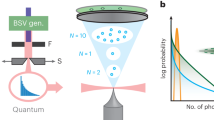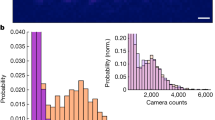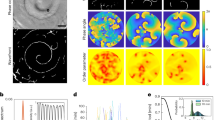Abstract
Although collisions between atoms and molecules are largely understood, collisions between two molecules have proven much harder to study. In both experiment and theory, our ability to determine quantum-state-resolved bimolecular cross-sections lags behind their atom–molecule counterparts by decades. For many bimolecular systems, even rules of thumb—much less intuitive understanding—of scattering cross sections are lacking. Here, we report the measurement of state-to-state differential cross sections on the collision of state-selected and velocity-controlled nitric oxide (NO) radicals and oxygen (O2) molecules. Using velocity map imaging of the scattered NO radicals, the full product-pair correlations of rotational excitation that occurs in both collision partners from individual encounters are revealed. The correlated cross sections show surprisingly good agreement with quantum scattering calculations using ab initio NO−O2 potential energy surfaces. The observations show that the well-known energy-gap law that governs atom–molecule collisions does not generally apply to bimolecular excitation processes, and reveal a propensity rule for the vector correlation of product angular momenta.
This is a preview of subscription content, access via your institution
Access options
Access Nature and 54 other Nature Portfolio journals
Get Nature+, our best-value online-access subscription
$29.99 / 30 days
cancel any time
Subscribe to this journal
Receive 12 print issues and online access
$259.00 per year
only $21.58 per issue
Buy this article
- Purchase on Springer Link
- Instant access to full article PDF
Prices may be subject to local taxes which are calculated during checkout




Similar content being viewed by others
References
Kramer, K. H. & Bernstein, R. B. Focusing and orientation of symmetric-top molecules with the electric six-pole field. J. Chem. Phys. 42, 767–770 (1965).
van de Meerakker, S. Y. T., Bethlem, H. L., Vanhaecke, N. & Meijer, G. Manipulation and control of molecular beams. Chem. Rev. 112, 4828–4878 (2012).
van de Meerakker, S. Y. T., Bethlem, H. L. & Meijer, G. Taming molecular beams. Nat. Phys. 4, 595–602 (2008).
Stolte, S. Aiming the molecular arrow. Nature 353, 391–392 (1991).
Chandler, D. W. & Stolte, S. in Gas Phase Molecular Reaction and Photodissociation Dynamics (Lin, K. C. & Kleiber, P. D.) Ch. 1 (Transworld Research Network, Kerala, 2007).
Aoiz, F. J. et al. A new perspective: imaging the stereochemistry of molecular collisions. Phys. Chem. Chem. Phys. 17, 30210–30228 (2015).
Wang, F., Liu, K. & Rakitzis, T. P. Revealing the stereospecific chemistry of the reaction of Cl with aligned CHD3 (v 1=1). Nat. Chem. 4, 636 (2012).
Costen, M. L., Marinakis, S. & McKendrick, K. G. Do vectors point the way to understanding energy transfer in molecular collisions? Chem. Soc. Rev. 37, 732–743 (2008).
Brouard, M., Hornung, B. & Aoiz, F. J. Origin of collision-induced molecular orientation. Phys. Rev. Lett. 111, 183202 (2013).
Brouard, M., Chadwick, H., Eyles, C. J., Aoiz, F. J. & Kłos, J. The k−j−j′ vector correlation in inelastic and reactive scattering. J. Chem. Phys. 135, 084305 (2011).
Onvlee, J. et al. Imaging quantum stereodynamics through fraunhofer scattering of NO radicals with rare-gas atoms. Nat. Chem. 9, 226–233 (2017).
Chefdeville, S. et al. Appearance of low energy resonances in CO-para-H2 inelastic collisions. Phys. Rev. Lett. 109, 023201 (2012).
Kirste, M. et al. Quantum-state resolved bimolecular collisions of velocity-controlled OH with NO radicals. Science 338, 1060–1063 (2012).
Liu, K. Product pair correlation in bimolecular reactions. Phys. Chem. Chem. Phys. 9, 17–30 (2007).
Buck, U., Huisken, F., Maneke, G. & Schaefer, J. State resolved rotational excitation in HD+D2 collisions. ii. Angular dependence of 0→2 transitions. J. Chem. Phys. 78, 4430–4438 (1983).
Townsend, D. et al. The roaming atom: straying from the reaction path in formaldehyde decomposition. Science 306, 1158–1161 (2004).
Hause, M. L., Herath, N., Zhu, R., Lin, M. C. & Suits, A. G. Roaming-mediated isomerization in the photodissociation of nitrobenzene. Nat. Chem. 3, 932–937 (2011).
Grubb, M. P. et al. No straight path: roaming in both ground- and excited-state photolytic channels of NO3 →NO+O2. Science 335, 1075–1078 (2012).
Zhang, Z. et al. Imaging the pair-correlated HNCO photodissociation: The NH(a1Δ)+CO(X1Σ+) channel. J. Phys. Chem. A 118, 2413–2418 (2014).
Lin, J. J., Zhou, J., Shiu, W. & Liu, K. State-specific correlation of coincident product pairs in the F+CD4 reaction. Science 300, 966–969 (2003).
Yan, S., Wu, Y.-T., Zhang, B., Yue, X.-F. & Liu, K. Do vibrational excitations of CHD3 preferentially promote reactivity toward the chlorine atom? Science 316, 1723–1726 (2007).
Zhang, W., Kawamata, H. & Liu, K. CH stretching excitation in the early barrier F+CHD3 reaction inhibits CH bond cleavage. Science 325, 303–306 (2009).
Wang, F., Lin, J.-S. & Liu, K. Steric control of the reaction of CH stretch–excited CHD3 with chlorine atom. Science 331, 900–903 (2011).
Wang, T. et al. Dynamical resonances accessible only by reagent vibrational excitation in the F+HD → HF+D reaction. Science 342, 1499–1502 (2013).
Yang, T. et al. Extremely short-lived reaction resonances in Cl+HD (v=1) → DCl+H due to chemical bond softening. Science 347, 60–63 (2015).
Brouard, M. et al. Angular distributions for the inelastic scattering of NO(X2Π) with O2(X3 \({{\rm{\Sigma }}}_{{\rm{g}}}^{-}\)). J. Chem. Phys. 146, 204304 (2017).
Luxford, T. F. M., Sharples, T. R., McKendrick, K. G. & Costen, M. L. Pair-correlated stereodynamics for diatom-diatom rotational energy transfer: NO(A2Σ+)+N2. J. Chem. Phys. 147, 013912 (2017).
Gijsbertsen, A., Linnartz, H. & Stolte, S. Parity-dependent rotational rainbows in D2-NO and He-NO differential collision cross sections. J. Chem. Phys. 125, 133112 (2006).
Yang, C.-H., Sarma, G., Parker, D. H., ter Meulen, J. J. & Wiesenfeld, L. State-to-state differential and relative integral cross sections for rotationally inelastic scattering of H2O by hydrogen. J. Chem. Phys. 134, 204308 (2011).
Tkáč, O., Rusher, C. A., Greaves, S. J., Orr-Ewing, A. J. & Dagdigian, P. J. Differential and integral cross sections for the rotationally inelastic scattering of methyl radicals with H2 and D2. J. Chem. Phys. 140, 204318 (2014).
Tkáč, O. et al. Rotationally inelastic scattering of ND3 with H2 as a probe of the intermolecular potential energy surface. Mol. Phys. 113, 3925–3933 (2015).
von Zastrow, A. et al. State-resolved diffraction oscillations imaged for inelastic collisions of NO radicals with He, Ne and Ar. Nat. Chem. 6, 216–221 (2014).
Vogels, S. N. et al. Imaging resonances in low-energy NO-He inelastic collisions. Science 350, 787–790 (2015).
Bacon, J. A., Giese, C. F. & Gentry, W. R. State-to-state differential cross sections for rotationally inelastic collisions of NO (2Π1/2, j≤2.5) with CO (1Σ+) and O2 (3 \({{\rm{\Sigma }}}_{{\rm{g}}}^{-}\)) at a kinetic energy of 442 cm−1. J. Chem. Phys. 108, 3127–3133 (1998).
Karman, T., van der Avoird, A. & Groenenboom, G. C. Communication: multiple-property-based diabatization for open-shell van der waals molecules. J. Chem. Phys. 144, 121101 (2016).
Onvlee, J., Vogels, S. N., von Zastrow, A., Parker, D. H. & van de Meerakker, S. Y. T. Molecular collisions coming into focus. Phys. Chem. Chem. Phys. 16, 15768–15779 (2014).
Yan, B. et al. A new high intensity and short-pulse molecular beam valve. Rev. Sci. Instrum. 84, 023102 (2013).
Townsend, D., Minitti, M. P. & Suits, A. G. Direct current slice imaging. Rev. Sci. Instrum. 74, 2530–2539 (2003).
Even, U. Pulsed supersonic beams from high pressure source: Simulation results and experimental measurements. Adv. Chem. 2014, 1–11 (2014).
Acknowledgements
The research leading to these results has received funding from the European Research Council under the European Union’s Seventh Framework Programme (FP7/2007–2013), ERC grant agreement 335646 MOLBIL. This work is part of the research program of the Netherlands Organization for Scientific Research (NWO). The expert technical support by N. Janssen, A. van Roij and E. Sweers is gratefully acknowledged.
Author information
Authors and Affiliations
Contributions
The experiments were conceived by S.Y.T.v.d.M. The experiments were carried out by Z.G. with the help of S.N.V. Data analysis and simulations were performed by Z.G. Potential energy surfaces were calculated by T.K., A.v.d.A. and G.C.G. Scattering calculations were performed by T.K. and M.B. Analysis of quantum entanglement was performed by T.K. All authors were involved in the interpretation of the data, discussed the results, and commented on the manuscript. The paper was written by Z.G., T.K. and S.Y.T.v.d.M. with contributions from all authors.
Corresponding authors
Ethics declarations
Competing interests
The authors declare no competing interests.
Additional information
Publisher’s note: Springer Nature remains neutral with regard to jurisdictional claims in published maps and institutional affiliations.
Supplementary information
Supplementary Information
Supplementary Methods, Analysis and Calculations; Supplementary Figs. 1–14
Rights and permissions
About this article
Cite this article
Gao, Z., Karman, T., Vogels, S.N. et al. Observation of correlated excitations in bimolecular collisions. Nature Chem 10, 469–473 (2018). https://doi.org/10.1038/s41557-018-0004-0
Received:
Accepted:
Published:
Issue Date:
DOI: https://doi.org/10.1038/s41557-018-0004-0
This article is cited by
-
Glory scattering in deeply inelastic molecular collisions
Nature Chemistry (2022)
-
Direct observation of a Feshbach resonance by coincidence detection of ions and electrons in Penning ionization collisions
Nature Communications (2020)
-
Molecular collisions: A crash course in energy transfer
Nature Reviews Chemistry (2018)



